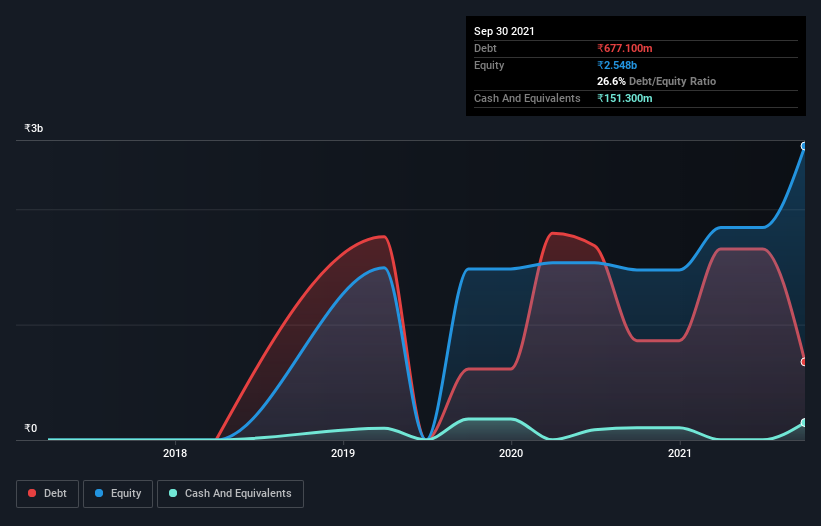The external fund manager backed by Berkshire Hathaway's Charlie Munger, Li Lu, makes no bones about it when he says 'The biggest investment risk is not the volatility of prices, but whether you will suffer a permanent loss of capital.' So it seems the smart money knows that debt - which is usually involved in bankruptcies - is a very important factor, when you assess how risky a company is. As with many other companies DCM Nouvelle Limited (NSE:DCMNVL) makes use of debt. But the more important question is: how much risk is that debt creating?
What Risk Does Debt Bring?
Generally speaking, debt only becomes a real problem when a company can't easily pay it off, either by raising capital or with its own cash flow. If things get really bad, the lenders can take control of the business. However, a more common (but still painful) scenario is that it has to raise new equity capital at a low price, thus permanently diluting shareholders. Of course, debt can be an important tool in businesses, particularly capital heavy businesses. When we examine debt levels, we first consider both cash and debt levels, together.
See our latest analysis for DCM Nouvelle
What Is DCM Nouvelle's Net Debt?
The image below, which you can click on for greater detail, shows that DCM Nouvelle had debt of ₹677.1m at the end of September 2021, a reduction from ₹860.3m over a year. On the flip side, it has ₹151.3m in cash leading to net debt of about ₹525.8m.

How Strong Is DCM Nouvelle's Balance Sheet?
We can see from the most recent balance sheet that DCM Nouvelle had liabilities of ₹1.14b falling due within a year, and liabilities of ₹155.6m due beyond that. Offsetting these obligations, it had cash of ₹151.3m as well as receivables valued at ₹1.28b due within 12 months. So it can boast ₹135.5m more liquid assets than total liabilities.
This short term liquidity is a sign that DCM Nouvelle could probably pay off its debt with ease, as its balance sheet is far from stretched.
We measure a company's debt load relative to its earnings power by looking at its net debt divided by its earnings before interest, tax, depreciation, and amortization (EBITDA) and by calculating how easily its earnings before interest and tax (EBIT) cover its interest expense (interest cover). The advantage of this approach is that we take into account both the absolute quantum of debt (with net debt to EBITDA) and the actual interest expenses associated with that debt (with its interest cover ratio).
DCM Nouvelle's net debt is only 0.33 times its EBITDA. And its EBIT easily covers its interest expense, being 35.7 times the size. So we're pretty relaxed about its super-conservative use of debt. Better yet, DCM Nouvelle grew its EBIT by 1,335% last year, which is an impressive improvement. That boost will make it even easier to pay down debt going forward. When analysing debt levels, the balance sheet is the obvious place to start. But it is DCM Nouvelle's earnings that will influence how the balance sheet holds up in the future. So if you're keen to discover more about its earnings, it might be worth checking out this graph of its long term earnings trend.
Finally, while the tax-man may adore accounting profits, lenders only accept cold hard cash. So it's worth checking how much of that EBIT is backed by free cash flow. Over the last two years, DCM Nouvelle reported free cash flow worth 12% of its EBIT, which is really quite low. That limp level of cash conversion undermines its ability to manage and pay down debt.
Our View
The good news is that DCM Nouvelle's demonstrated ability to cover its interest expense with its EBIT delights us like a fluffy puppy does a toddler. But we must concede we find its conversion of EBIT to free cash flow has the opposite effect. Looking at the bigger picture, we think DCM Nouvelle's use of debt seems quite reasonable and we're not concerned about it. After all, sensible leverage can boost returns on equity. The balance sheet is clearly the area to focus on when you are analysing debt. However, not all investment risk resides within the balance sheet - far from it. For instance, we've identified 4 warning signs for DCM Nouvelle (1 is potentially serious) you should be aware of.
If, after all that, you're more interested in a fast growing company with a rock-solid balance sheet, then check out our list of net cash growth stocks without delay.
New: Manage All Your Stock Portfolios in One Place
We've created the ultimate portfolio companion for stock investors, and it's free.
• Connect an unlimited number of Portfolios and see your total in one currency
• Be alerted to new Warning Signs or Risks via email or mobile
• Track the Fair Value of your stocks
Have feedback on this article? Concerned about the content? Get in touch with us directly. Alternatively, email editorial-team (at) simplywallst.com.
This article by Simply Wall St is general in nature. We provide commentary based on historical data and analyst forecasts only using an unbiased methodology and our articles are not intended to be financial advice. It does not constitute a recommendation to buy or sell any stock, and does not take account of your objectives, or your financial situation. We aim to bring you long-term focused analysis driven by fundamental data. Note that our analysis may not factor in the latest price-sensitive company announcements or qualitative material. Simply Wall St has no position in any stocks mentioned.
About NSEI:DCMNVL
DCM Nouvelle
Manufactures, exports, and sells cotton yarn in India, Bangladesh, China, Egypt, Guatemala, and internationally.
Mediocre balance sheet with low risk.
Market Insights
Community Narratives



